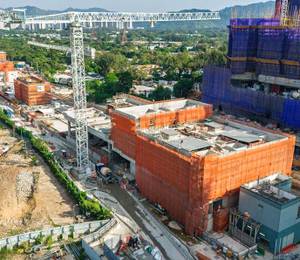Geotechnical contractor Keller has worked with oil giant ExxonMobil to construct more environment-friendly foundations for a major refinery expansion project in Jurong Island, Singapore.
ExxonMobil is expanding its operations with the construction of a major new refinery – the Chemical and Refining Integrated Singapore Project (CRISP) – that will increase production of cleaner fuels with lower sulphate content. Keller was awarded the design-build contract for the foundations for CRISP, working with the main contractor Técnicas Reunidas.
“The project had tanks and process plant structures such as pipe racks spread over an area of around 137,000 sq m and precast concrete spun piling would traditionally have been the choice for the foundations to satisfy the performance criteria,” explained Deepak Raj, managing director for Keller‘s ASEAN business unit. “However, having established a strong, trusted relationship between ourselves with ExxonMobil over many years, they had enough confidence in us to ask if we could find a better, more innovative way to do the job.”
Based on the engineering requirements for the structures and the soil conditions, Keller proposed an alternative hybrid foundation solution of deep vibro compaction to densify the top sandy layers, along with vibro stone columns to reinforce the soft clayey strata underneath.
Not only are these methods together around 35-40% faster and more cost-effective than the traditional piling solution, but they’re also much more environment-friendly, said Keller.
“Piling contains rebar and concrete, so you need a lot of steel and cement – materials that use a lot of energy and produce high levels of CO2 emissions to manufacture,” highlighted Mr Raj. According to the International Energy Agency, the construction industry is responsible for around 40% of CO2 emissions, with about 8% coming from cement production.
Mr Raj said, “As a leading geotechnical contractor, it’s our moral responsibility to contribute towards a more sustainable future and look at reducing CO2 wherever possible.”
A huge saving
Keller’s engineers used a universal carbon calculator devised by industry bodies the European Federation of Foundation Contractors and the Deep Foundations Institute to compare the piling proposal with Keller’s vibro solutions.
“The result includes everything from the diesel used to power machines and material production, right through to worker transportation and waste disposal and revealed a stark difference,” said Keller.
“The piling option would have generated around 22,000 metric tonnes of carbon dioxide equivalent (tCO2e), while the vibro methods produced just 1,900 tCO2e – 92% lower, saving the equivalent of driving the average car around the earth 2,000 times.”
Notably, materials consumption accounted for only 96 tCO2e of the vibro carbon total, added Keller. “That’s because natural crushed stone is far less carbon intensive than manufactured materials, produces no waste and is lighter, reducing the number of trips needed to bring it to site.”
Most of the emissions – 1,369 tCO2e – came from the diesel used to power Keller’s machines. But here too, Keller is minimising its impact. “The stone columns were installed with in-house designed and manufactured vibrocats, which are increasingly efficient and have lower fuel emissions compared to crane-hung rigs.”
“For companies like ExxonMobil, sustainability is increasingly important,” said Mr Raj. “So if we can show how techniques are not only quicker and more cost-effective, but also much more environmentally friendly, that’s great for them, for us and for the planet.”
Photo © Keller











